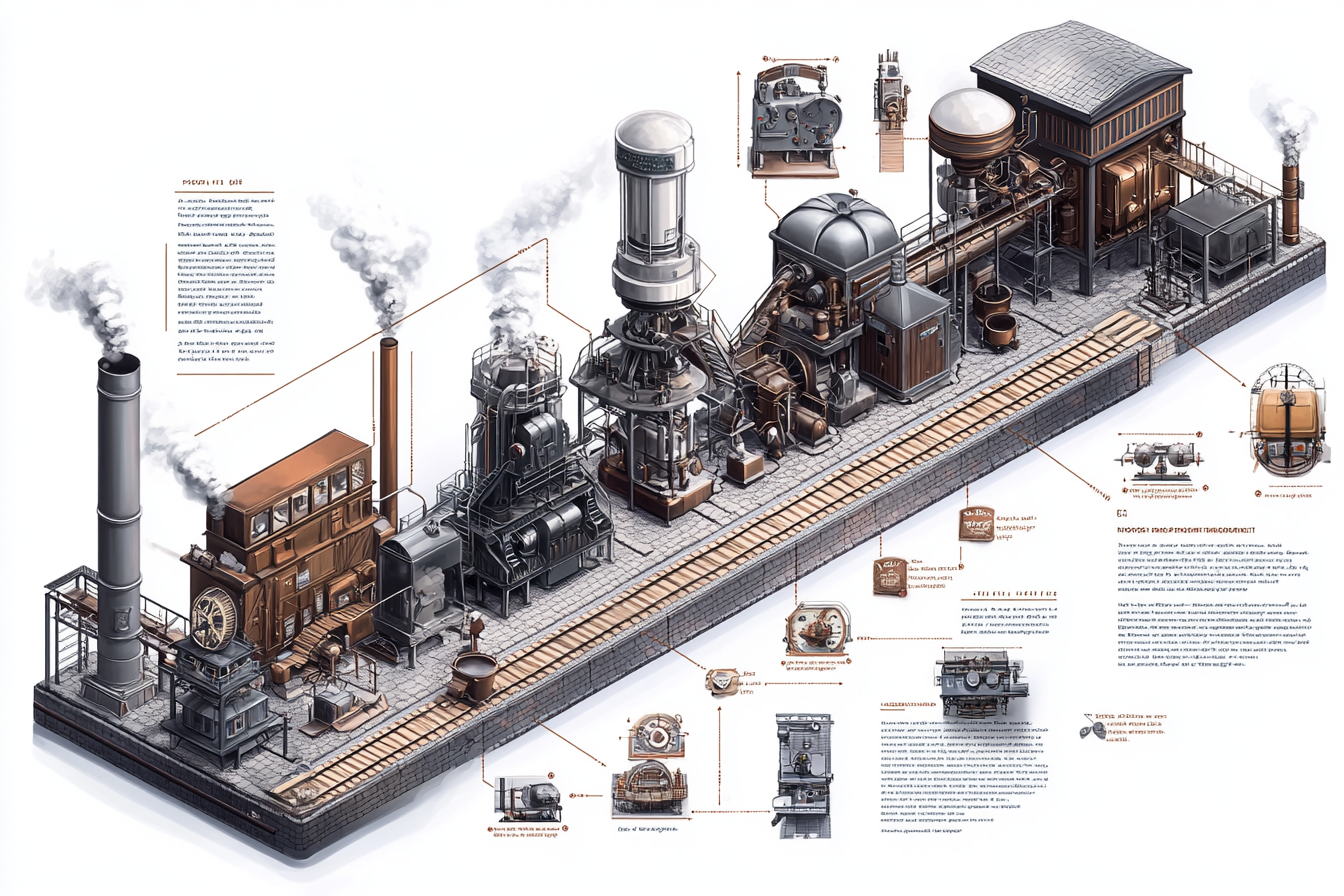Automation is revolutionizing industries and transforming the way businesses operate by increasing efficiency, reducing errors, and optimizing resources. As organizations around the world embrace automation technologies, they are able to stay competitive and meet the ever-evolving demands of their customers.
Key Takeaways
- What is Automation?: Automation involves using technology to perform tasks with minimal human intervention.
- Benefits of Automation: Cost reductions, improved accuracy, enhanced quality, and increased productivity.
- Applications: From business process automation (BPA) in enterprises to robotics in manufacturing and home automation for consumers.
- Historical Context: The concept of automation has evolved since ancient times and has been accelerated by advancements in technology during the Industrial Revolution and beyond.
- Societal Impact: Automation has implications for job displacement but can also enhance sustainability depending on technology employment.
Explore modern Automation solutions at ipsom.io.
Understanding Automation
- Automation: The application of technology to perform tasks automatically, minimizing human input in processes.
- Importance of Automation: Leads to predefined decision-making and efficient task execution.
- Prevalence Across Sectors: Common in industrial, transportation, banking, and consumer applications.
Definition and Importance
- Time and Effort Reduction: Automation significantly decreases the time and effort involved in manual tasks.
- Competitiveness: Essential for organizations to understand automation in today's fast-paced business environment.
- Key Benefits:
- Greater Productivity
- Better Accuracy
- Reduced Operational Costs
Scope and Reach
- Extensive Scope: Automation spans various domains and industries.
- Manufacturing: Streamlining production lines.
- Banking: Enhancing customer service through automated systems.
- Consumer Applications: Utilizing smart devices for convenience in homes.
- Identifying Opportunities: Understanding the reach of automation allows organizations to pinpoint potential benefits.
Goals of Automation
The primary goals of automation include:
- Enhanced Efficiency: Optimizes operational workflows to allow organizations to accomplish more in less time.
- Cost and Resource Reduction: Saves on labor costs and minimizes material waste through automated processes.
- Compliance and Quality Improvement: Ensures consistency in meeting industry standards, leading to higher product quality and accuracy.
Organizations that implement automation effectively experience substantial benefits, making it a vital component for future growth and sustainability.
Historical Development of Automation
The historical development of automation showcases significant innovations that have shaped industries over time. From ancient innovations to modern technology, the journey of automation is both inspiring and enlightening.
Ancient Innovations
- Early Concepts: Automation traces back to the ancient Greeks and Arabs.
- Reduction of Manual Efforts: Introduction of devices that minimized human labor.
- Notable Example:
- Ctesibius's Water Clock: An early example of mechanization that set the stage for future innovations.
The Industrial Revolution
- Turning Point: The Industrial Revolution marked a significant shift in automation.
- Technological Advancements:
- Emergence of Automated Looms: Revolutionized textile manufacturing.
- Steam Engine Control Systems: Enhanced efficiency in various industries.
- Adoption of Mechanical Processes: Factories began to embrace these innovations, laying the groundwork for modern automation.
20th Century Breakthroughs
- Groundbreaking Developments: The 20th century saw monumental progress in automation technology.
- Key Innovations:
- Relay Logic: Improved manufacturing processes with enhanced control.
- Programmable Logic Controllers (PLCs): Allowed for greater precision and flexibility in operations.
- Digital Control Systems: Enabled real-time monitoring and automation, significantly boosting productivity.
Overall, the historical development of automation illustrates a consistent trend towards reducing manual labor while enhancing efficiency across various sectors.
Applications of Automation
Automation plays a vital role across various sectors, significantly transforming operations and efficiency. Each application offers unique benefits tailored to specific industry needs, enhancing both productivity and quality.
Industrial Automation
- Prevalent Sectors
- Core industries such as power generation and automotive manufacturing.
- Key Technologies
- Integration of robots and automated systems.
- Benefits
- Increases precision and speed in production.
- Reduces human error and enhances operational safety.
- Contributes to overall efficiency.
Business Process Automation (BPA)
- Purpose
- Streamlines enterprise operations, improving efficiency and customer satisfaction.
- Key Features
- Automates repetitive tasks, allowing focus on strategy and growth.
- Benefits
- Maintains compliance with industry standards.
- Supports effective decision-making.
Consumer Applications
- Home Automation
- Technologies increase convenience with smart thermostats and automated lighting systems.
- Retail Automation
- Includes self-checkout systems to enhance the shopping experience.
- Makes shopping faster and more efficient.
Agricultural Automation
- Mechanization and Digital Technologies
- Drives productivity improvements in farming.
- Benefits
- Helps farmers manage crops and livestock more effectively.
- Leads to better yields and resource management.
Logistics and Supply Chain Automation
- Essential Technologies
- Enhances inventory management through effective tracking of stock levels.
- Benefits
- Streamlines operations and enables real-time data access.
- Improves decision-making and reduces delays.
Explore modern automation solutions at ipsom.io.
Benefits and Challenges of Automation
Automation brings numerous benefits to businesses and society. However, it also presents certain challenges that organizations must navigate.
Advantages
One of the key benefits of automation is increased productivity. By automating repetitive tasks, businesses can save labor costs and enhance efficiency. Automation also leads to quality improvements. Greater accuracy and precision reduce manufacturing defects, which results in higher-quality products. This boosts customer satisfaction and strengthens brand reputation.
Additionally, automation helps organizations respond quickly to market demands. With streamlined processes, companies can achieve faster turnaround times and improve overall operational agility.
Challenges
Despite its advantages, automation comes with challenges. One significant barrier is the initial cost. The implementation of automation systems can require substantial investment, which may deter smaller businesses. The complexity of integrating these systems can further complicate the process.
Another challenge is job displacement. As tasks become automated, there is a risk that lower-skilled jobs may diminish. This raises concerns about the societal impact, prompting discussions on workforce reskilling and adequate support for affected workers. Addressing these challenges is essential to leverage automation's full potential while minimizing adverse effects on employment.
The Future of Automation
The future of automation is shaped by rapid technological advancements and changing societal needs. As businesses increasingly adopt automation, they confront both exciting opportunities and significant challenges.
The Paradox of Automation
While automation enhances efficiency, it also creates a paradox. More complex automated systems require skilled operators to manage and maintain them. This raises the demand for employees with advanced skill sets. Training and reskilling become essential for the workforce to adapt to this new landscape. Businesses must invest in their employees to harness the full potential of their automation technologies.
Sociocultural Implications
Automation leads to profound sociocultural implications. The theory of Universal Basic Income (UBI) is gaining traction as a potential solution for those displaced by automation. As traditional jobs evolve or become obsolete, UBI could provide a safety net for displaced workers, ensuring basic financial support while they transition to new roles.
Environmental Impact
The environmental impact of automation hinges on the technologies employed. If integrated wisely, automation can promote sustainability. For instance, automated systems can optimize resource usage and minimize waste, leading to reduced environmental footprints. However, improper implementation may exacerbate resource depletion. Companies must evaluate sustainability considerations when adopting automation to contribute positively to the environment.
As automation continues to evolve, businesses and society will need to navigate its complexities while leveraging its benefits for a more efficient future.
Cognitive Automation and Industry 4.0
Cognitive automation combines artificial intelligence with automation to enhance productivity. It focuses on automating clerical tasks by using AI algorithms to process unstructured data, such as emails and documents. This enables businesses to streamline operations and reduce human intervention in repetitive tasks.
Definition and Role
Cognitive automation plays a pivotal role in transforming how organizations operate. By mimicking human reasoning and decision-making, it allows for improved data analysis and task execution. This innovation not only increases efficiency but also frees employees to focus on more strategic tasks. Ultimately, cognitive automation helps businesses enhance their performance and decision-making capabilities.
Industry 4.0
Industry 4.0 represents the new era of manufacturing, characterized by the integration of digital technologies and the Internet of Things (IoT). This shift encourages smart manufacturing, where machines communicate and collaborate in real-time. As cognitive automation becomes a key component, manufacturers can optimize their processes, reduce downtime, and improve product quality.
The combination of cognitive automation and Industry 4.0 paves the way for a more connected and efficient manufacturing landscape, enabling organizations to respond swiftly to market changes and consumer demands.
Conclusion
The continuous evolution in automation technologies is reshaping industries. Key points include:
-
Adoption of Automated Systems: Businesses are increasingly utilizing automation to enhance:
- Efficiency
- Innovation
-
Reduction of Human Error: Automated systems help in optimizing resources, allowing organizations to maintain a competitive edge.
Opportunities Created by Automation
As automation technologies advance, they open up new possibilities across various sectors:
- Industrial Automation: Streamlining manufacturing processes.
- Business Process Automation: Enhancing efficiency in administrative tasks.
- Consumer Applications: Improving user experiences and convenience.
Challenges to Consider
While advancements offer significant benefits, they also pose challenges that need attention:
- Job Displacement: The transition to automation may lead to workforce changes and job loss.
- Need for Skilled Operators: A shift in skills requirement to manage and maintain automated systems.
- Societal and Environmental Impact: Evaluating how automation affects sustainable development is crucial.
The Transformative Power of Automation
Organizations that embrace automation can:
- Transform Operations: Streamlining processes for better efficiency.
- Improve Service Delivery: Meeting customer demands effectively and quickly.
The future of automation promises:
- Greater Advancements: Continued innovation that enhances capabilities.
- An Interconnected World: A more efficient system that bridges various sectors for collaboration and growth.
FAQ
What is automation and how does it work?
Automation is the use of technology to perform tasks with minimal human intervention. It works by executing predefined rules, allowing machines or software to carry out processes efficiently.
What are the benefits of automating business processes?
Automating business processes leads to cost reductions, improved accuracy, enhanced quality, and increased productivity. Automation streamlines repetitive tasks, freeing up human resources for more strategic work.
How is automation impacting job markets?
Automation can displace jobs, particularly low-skilled roles, but it also creates demand for new skill sets. Many organizations need skilled workers to manage automated systems and technology.
What industries are most affected by automation?
Industries like manufacturing, transportation, healthcare, and retail are heavily impacted. Automation improves efficiency and accuracy in these sectors, leading to transformational changes.
How does automation contribute to digital transformation?
Automation is a key driver of digital transformation. It enables organizations to modernize operations, improve customer experiences, and adapt to changes in market demands through technological integration.
What is the role of robotics in industrial automation?
Robotics plays a crucial role in industrial automation by performing repetitive and dangerous tasks with high precision. Robots enhance productivity and reduce manufacturing errors.
What challenges do organizations face when implementing automation?
Organizations face challenges such as high initial costs, the need for change management, employee resistance, and concerns about job displacement. Addressing these challenges is vital for successful implementation.
How can businesses prepare for the societal impacts of automation?
Businesses can prepare by investing in employee training, focusing on skill development, and promoting new recruitment strategies. This helps mitigate the negative effects of job displacement.
What technologies are driving advancements in automation?
Technologies such as AI, machine learning, IoT, and robotics are driving advancements in automation. These technologies enhance capabilities and improve operational efficiency.
How does cognitive automation differ from traditional automation methods?
Cognitive automation uses AI to handle unstructured data and replicate human thought processes. It differs from traditional automation by enabling decision-making capabilities and handling complex tasks.








